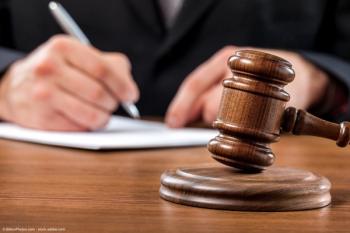
- Vol 48 No 1
- Volume 48
- Issue 1
IPP suit hinges on expert’s lack of credibility
"The expert testified that the standard of care after penile prosthesis surgery is to leave the implant in a semi-inflated state for 4 to 6 weeks, when in fact the standard is to keep the implant in a deflated state," writes Brianne Goodwin, JD, RN.
A 61-year-old male with medical history including a cardiac condition, four back surgeries, and lung cancer presented to his urologist for erectile dysfunction, which he had been suffering from for approximately 5 years. He was first given the options of vacuum pump therapy and penile injections, both of which he tried, but which failed to help his condition.
Less than 2 years later, after exhausting these two options, the patient opted to undergo placement of an inflatable penile prosthesis. The surgery was done by an attending physician, with the assistance of a senior resident and observation by a junior resident. Based on measurements done by the attending and resident, it was documented that an 18-cm implant would be used in conjunction with two rear tip extenders.
The prosthesis was inflated during the procedure after placement, and it was documented that a sufficient erection was produced with a mild deviation to the right. The patient tolerated the procedure well and there were no complications. He stayed overnight in the hospital and was discharged the following day.
Also see:
The man was seen in clinic 3 weeks postoperatively, where he was examined by another resident who noted a bulge on the left side of the man’s penis. The patient noted he had not yet used the prosthesis, had soreness with sitting, but had no other complaints.
The resident inflated the prosthesis and brought the surgical attending into the room to examine the patient as well. It was documented that the man had no bruising, his incision was healing well, and the bulge could represent a kink in the cylinder of the prosthetic device. He was scheduled to return 3 weeks later to be reassessed.
Device removed after 14 months
Reassessment 3 weeks later revealed the bulge was still present and upon inflation of the prosthesis, there was a severe bend to the right. The man was bothered with the hardware and ultimately decided to have it removed. The same surgeon who placed the prosthesis removed it approximately 14 months later.
The man began treatment with another urologist several months later with complaints of pain in his penis and scrotum and ultimately filed a lawsuit alleging negligence on the part of the surgeon who implanted the prosthesis. The man’s claims were three: the defendant did not accurately measure the left corpora; the prosthesis was never properly seated in the proximal end of the penis, making it too large; and the defendant punctured the tunica albuginea when they dilated the left corpora, allowing the prosthesis to bulge. All of these, the plaintiff alleged, were deviations from the standard of care.
In this case, as in most, the standard of care in medical malpractice proceedings is established by expert witnesses and testimony. The defendant’s expert witness, who had performed several hundred penile implant prosthesis procedures over the years, testified that if a prosthesis is not properly sized, it will buckle out through the incision in the corpora. To assure proper sizing, the prosthesis should be inflated during the surgery. This was documented in the operative note to have occurred three times during the surgery while checking the appearance of the implant.
In addition, the defendant’s expert testified that tearing the tunica albuginea while dilating the corpora is nearly impossible. He elaborated that the corpora are dilated in proximal and distal directions, meaning that a surgeon would need to rotate the dilator 90 degrees, and with enough force, to tear a membrane that is fibrous in nature. Moreover, had that membrane been torn, there would be thickened scar tissue in the area, which was not noted on the patient’s exam at the time of prosthesis removal.
The plaintiff’s expert witness, also his treating urologist, failed to establish the credibility needed to come close to that of the defendant’s expert. As an initial matter, the plaintiff’s expert testified that in 27 years of practice he had performed six inflatable penile prosthesis procedures, with the most recent one being 10 to 15 years ago. Furthermore, plaintiff’s expert had not previously examined one patient with the symptom of a bulge after penile prosthesis surgery.
The plaintiff’s expert demonstrated lack of knowledge on cross examination when asked about the standard of care postoperatively. Specifically, the expert testified that the standard of care after penile prosthesis surgery is to leave the implant in a semi-inflated state for 4 to 6 weeks, when in fact the standard is to keep the implant in a deflated state. Credibility further suffered when the plaintiff’s expert testified that the tunica albuginea and the Buck’s fascia were the same anatomy.
Next:
Further questioning revealed that plaintiff’s expert made no attempts to stay current on urologic research, was not a member of any professional urologic organizations, did not subscribe to any medical journals, and could only provide the title of one journal in his field of practice. This expert changed his testimony during the trial, further crippling the plaintiff’s case.
Read:
The plaintiff himself contributed negatively to his case as well. His description of events at postoperative visits differed significantly from what was documented in the medical record. He also was found to have exaggerated and omitted important portions of his medical history when testifying in other unrelated administrative proceedings.
Accordingly, the court found that the plaintiff failed to prove that defendant deviated from the standard of care and judgment was entered in favor of the defendant.
Articles in this issue
almost 6 years ago
New agents may offer hope for two forms of hyperoxaluriaalmost 6 years ago
Protocol cuts narcotic use in IPP patientsalmost 6 years ago
Pembrolizumab granted new bladder Ca indicationalmost 6 years ago
FDA approves enfortumab for locally advanced or metastatic urothelial Caalmost 6 years ago
Could mpMRI replace prostate Bx for surveillance protocols?almost 6 years ago
OnabotA use on the rise for neurogenic bladderalmost 6 years ago
Study of stone pain stresses personalized treatmentalmost 6 years ago
Panel crafts recommendations for cath management following BPH surgeryalmost 6 years ago
Pain-focused stone patients less likely to reach treatment goalsalmost 6 years ago
The physician executive: How one urologist balances MD, CEO rolesNewsletter
Stay current with the latest urology news and practice-changing insights — sign up now for the essential updates every urologist needs.


















